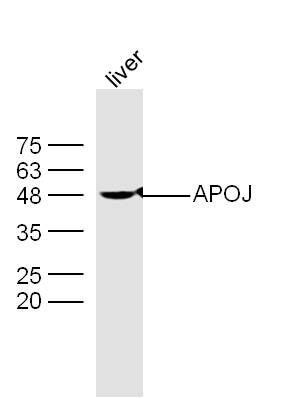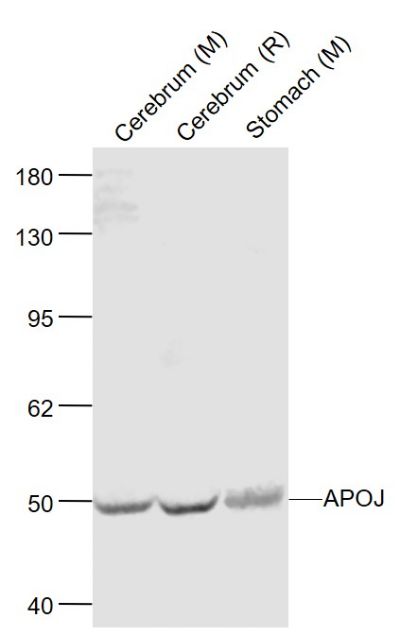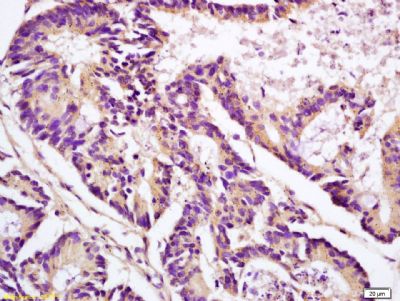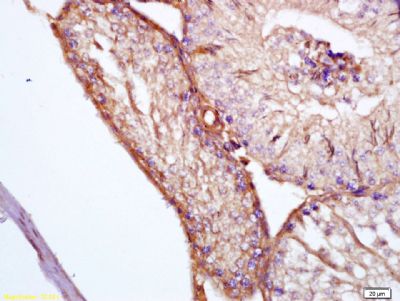载脂蛋白J抗体
产品名称: 载脂蛋白J抗体
英文名称: APOJ
产品编号: 1354
产品价格: null
产品产地: 上海
品牌商标: 雅吉
更新时间: null
使用范围: WB ELISA IHC-P IHC-F IF
上海雅吉生物科技有限公司
- 联系人 :
- 地址 : 上海市闵行区元江路5500号第1幢5658室
- 邮编 :
- 所在区域 : 上海
- 电话 : 158****3937 点击查看
- 传真 : 点击查看
- 邮箱 : yajikit@163.com
| 中文名称 | 载脂蛋白J抗体 |
| 别 名 | AAG 4; AAG4 ;Aging associated protein 4; Clusterin-alpha/beta; APOJ; Apo J; Apolipoprotein J; Cli; CLU; Clusterin alpha chain; Clusterin; Clusterin beta chain; Complement associated protein SP 40 40; Complement associated protein SP 40; Complement associated protein SP40; Complement cytolysis inhibitor; Complement lysis inhibitor; KUB 1; KUB1; MGC24903; NA1/NA2; SGP 2; SGP2; SP 40; SP40; Sulfated glycoprotein 2; Testosterone repressed prostate message 2; TRPM 2; TRPM2; Clusterin- Alpha/Beta; Apolipoprotein J. |
| 研究领域 | 肿瘤 心血管 细胞生物 免疫学 脂蛋白 |
| 抗体来源 | Rabbit |
| 克隆类型 | Polyclonal |
| 交叉反应 | Human, Mouse, Rat, |
| 产品应用 | WB=1:100-500 ELISA=1:500-1000 IHC-P=1:100-500 IHC-F=1:100-500 IF=1:100-500 (石蜡切片需做抗原修复) not yet tested in other applications. optimal dilutions/concentrations should be determined by the end user. |
| 分 子 量 | 50kDa |
| 细胞定位 | 分泌型蛋白 |
| 性 状 | Liquid |
| 浓 度 | 1mg/ml |
| 免 疫 原 | KLH conjugated synthetic peptide derived from human APO J:331-449/449 |
| 亚 型 | IgG |
| 纯化方法 | affinity purified by Protein A |
| 储 存 液 | 0.01M TBS(pH7.4) with 1% BSA, 0.03% Proclin300 and 50% Glycerol. |
| 保存条件 | Shipped at 4℃. Store at -20 °C for one year. Avoid repeated freeze/thaw cycles. |
| PubMed | PubMed |
| 产品介绍 | Apolipoprotein J is the major secreted product of Sertoli cells and is thought to play a critical role in spermatogenesis. The protein was shown to be a normal constituent of human blood and is also thought to be a control mechanism of the complement cascade. It prevents the binding of a C5b-C7 complex to the membrane of the target cell and in this way inhibits complement-mediated cytolysis. Apolipoprotein J is overexpressed in human prostate and breast cancers and in squamous cell carcinomas. Suppression of Apolipoprotein J renders these cells sensitive to chemotherapeutic drug-mediated apoptosis. It has been proposed that elevated levels of Apolipoprotein J may promote oncogenic transformation and tumor progression by interfering with BAX proapoptotic activities. Function: Isoform 1 functions as extracellular chaperone that prevents aggregation of nonnative proteins. Prevents stress-induced aggregation of blood plasma proteins. Inhibits formation of amyloid fibrils by APP, APOC2, B2M, CALCA, CSN3, SNCA and aggregation-prone LYZ variants (in vitro). Does not require ATP. Maintains partially unfolded proteins in a state appropriate for subsequent refolding by other chaperones, such as HSPA8/HSC70. Does not refold proteins by itself. Binding to cell surface receptors triggers internalization of the chaperone-client complex and subsequent lysosomal or proteasomal degradation. Secreted isoform 1 protects cells against apoptosis and against cytolysis by complement. Intracellular isoforms interact with ubiquitin and SCF (SKP1-CUL1-F-box protein) E3 ubiquitin-protein ligase complexes and promote the ubiquitination and subsequent proteasomal degradation of target proteins. Promotes proteasomal degradation of COMMD1 and IKBKB. Modulates NF-kappa-B transcriptional activity. Nuclear isoforms promote apoptosis. Mitochondrial isoforms suppress BAX-dependent release of cytochrome c into the cytoplasm and inhibit apoptosis. Plays a role in the regulation of cell proliferation. Subcellular Location: Nucleus. Cytoplasm. Mitochondrion membrane. Cytoplasm, cytosol. Microsome. Endoplasmic reticulum. Cytoplasmic vesicle, secretory vesicle, chromaffin granule. Isoforms lacking the N-terminal signal sequence have been shown to be cytoplasmic and/or nuclear. Secreted isoforms can retrotranslocate from the secretory compartments to the cytosol upon cellular stress. Detected in perinuclear foci that may be aggresomes containing misfolded, ubiquitinated proteins. Detected at the mitochondrion membrane upon induction of apoptosis and Secreted. Can retrotranslocate from the secretory compartments to the cytosol upon cellular stress. Tissue Specificity: Detected in blood plasma, cerebrospinal fluid, milk, seminal plasma and colon mucosa. Detected in the germinal center of colon lymphoid nodules and in colon parasympathetic ganglia of the Auerbach plexus (at protein level). Ubiquitous. Detected in brain, testis, ovary, liver and pancreas, and at lower levels in kidney, heart, spleen and lung. Post-translational modifications: Isoform 1 is proteolytically cleaved on its way through the secretory system, probably within the Golgi lumen. Polyubiquitinated, leading to proteasomal degradation. Heavily N-glycosylated. About 30% of the protein mass is comprised of complex N-linked carbohydrate. Similarity: Belongs to the clusterin family. SWISS: P10909 Gene ID: 1191 Database links: Entrez Gene: 1191 Human Entrez Gene: 12759 Mouse Entrez Gene: 24854 Rat Omim: 185430 Human SwissProt: P10909 Human SwissProt: Q06890 Mouse SwissProt: P05371 Rat Unigene: 436657 Human Unigene: 200608 Mouse Unigene: 1780 Rat Important Note: This product as supplied is intended for research use only, not for use in human, therapeutic or diagnostic applications. |
| 产品图片 |  Sample: Liver(Mouse) lysate at 30ug; Sample: Liver(Mouse) lysate at 30ug;Primary: Anti-APOJ(bs-1354R) at 1:200 dilution; Secondary: HRP conjugated Goat Anti-Rabbit IgG(bs-0295G-HRP) at 1: 5000 dilution; Predicted band size : 50kD Observed band size : 48kD  Sample: Sample:Cerebrum (Mouse) Lysate at 40 ug Cerebrum (Rat) Lysate at 40 ug Stomach (Mouse) Lysate at 40 ug Primary: Anti-APOJ (bs-1354R) at 1/1000 dilution Secondary: IRDye800CW Goat Anti-Rabbit IgG at 1/20000 dilution Predicted band size: 50 kD Observed band size: 50 kD  Tissue/cell: human colon carcinoma; 4% Paraformaldehyde-fixed and paraffin-embedded; Tissue/cell: human colon carcinoma; 4% Paraformaldehyde-fixed and paraffin-embedded;Antigen retrieval: citrate buffer ( 0.01M, pH 6.0 ), Boiling bathing for 15min; Block endogenous peroxidase by 3% Hydrogen peroxide for 30min; Blocking buffer (normal goat serum,C-0005) at 37℃ for 20 min; Incubation: Anti-APOJ/Clusterin Polyclonal Antibody, Unconjugated(bs-1354R) 1:200, overnight at 4°C, followed by conjugation to the secondary antibody(SP-0023) and DAB(C-0010) staining  Tissue/cell: rat testis tissue; 4% Paraformaldehyde-fixed and paraffin-embedded; Tissue/cell: rat testis tissue; 4% Paraformaldehyde-fixed and paraffin-embedded;Antigen retrieval: citrate buffer ( 0.01M, pH 6.0 ), Boiling bathing for 15min; Block endogenous peroxidase by 3% Hydrogen peroxide for 30min; Blocking buffer (normal goat serum,C-0005) at 37℃ for 20 min; Incubation: Anti-APOJ/Clusterin Polyclonal Antibody, Unconjugated(bs-1354R) 1:200, overnight at 4°C, followed by conjugation to the secondary antibody(SP-0023) and DAB(C-0010) staining |
